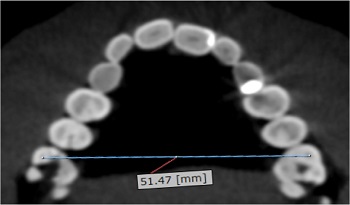Vol. 15 – Number 58 – 2022 Original article Page 107-111 Dimensional changes of maxillas with impacted canines Andrés Miguel Ribera Mendez¹ Silvia Amélia Scudeler Vedovello² Milton Santamaria Junior² Israel Chilvarquer³ Vivian Fernandes Furletti Góes² Abstract Objective: The purpose of the study was to evaluate measurements of the upper arch performed by Cone Beam Computed Tomography (CBCT) images of patients with impacted canines located in the vestibular and palatal areas. Method: The sample consisted of axial CBCT images of 63 patients of both genders (44 female and 19 male) with a mean age of 17.8 years. OnDemand® 3D software was used to obtain the measurements of intermolar distance, perimeter and maxillary length. Initially, descriptive and exploratory data analysis was performed. Student t test was applied to compare the two groups with unilaterally and bilaterally impacted canines, and analysis of variance (ANOVA) was used to compare the groups regarding the position the impacted canine, either vestibular or palatal. Reproducibility between measurements was evaluated by the intraclass correlation coefficient (ICC), considering the level of significance of 5%. Results: It was possible to verify that of the total number of volunteers, 39 individuals had unilaterally and 24 bilaterally impacted canines. Of these, 26 were in the vestibular position and 37 in the palatal position. It was observed that the intermolar distance was significantly smaller in the group with bilaterally impacted canines (p<0.05), the perimeter and maxillary arch length did not differ significantly among patients with unilaterally or bilaterally impacted canines (p>0.05). However, these parameters were significantly lower (p<0.05) in patients with impacted canines in the palatal position. Conclusions: Maxillas with bilaterally impacted canines present smaller intermolar distance, and palatal canines impacted are present in maxillary with the smallest arch perimeter. Descriptors: Tooth not erupted, spiral cone beam computed tomography, dental arch. ¹ Master’s student in Dentistry – FHO – UNIARARAS. ² Doctoral student at the Orthodontics Program – FHO – UNIARARAS. ³ Dental Residency Program – Oral and Maxillofacial Radiology. DOI: 10.24077/2022;1558-0195098
This content is restricted to site members. If you are an existing user, please log in. New users may register below.
LEIA MAIS

